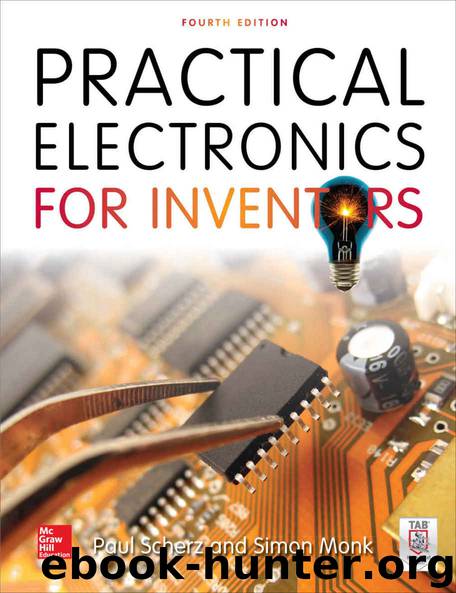Practical Electronics for Inventors, Fourth Edition by Paul Scherz & Simon Monk

Author:Paul Scherz & Simon Monk [Scherz, Paul]
Language: eng
Format: epub
ISBN: 9781259587542
Publisher: McGraw-Hill Education
Published: 2016-04-05T05:00:00+00:00
FIGURE 5.22
5.7.1 How a Phototransistor Works
Figure 5.23 shows a simple model of a two-lead bipolar phototransistor. The details of how this device works are given below.
FIGURE 5.23
The bipolar phototransistor resembles a bipolar transistor (with no base lead) that has an extra large p-type semiconductor region that is open for light exposure. When photons from a light source collide with electrons within the p-type semiconductor, they gain enough energy to jump across the pn-junction energy barrier—provided the photons are of the right frequency/energy. As electrons jump from the p region into the lower n region, holes are created in the p-type semiconductor. The extra electrons injected into the lower n-type slab are drawn toward the positive terminal of the battery, while electrons from the negative terminal of the battery are drawn into the upper n-type semiconductor and across the n-p junction, where they combine with the holes. The net result is an electron current that flows from the emitter to the collector. In terms of conventional currents, everything is backward. That is, you would say that when the base region is exposed to light, a positive current I flows from the collector to the emitter. Commercial phototransistors often place the pnp semiconductor in an epoxy case that also acts as a magnifying lens. Other phototransistors use a metal container and a plastic window to encase the chip.
Download
This site does not store any files on its server. We only index and link to content provided by other sites. Please contact the content providers to delete copyright contents if any and email us, we'll remove relevant links or contents immediately.
| Circuits | Digital Design |
| Electric Machinery & Motors | Electronics |
| Fiber Optics | Networks |
| Superconductivity |
Whiskies Galore by Ian Buxton(41883)
Introduction to Aircraft Design (Cambridge Aerospace Series) by John P. Fielding(33064)
Small Unmanned Fixed-wing Aircraft Design by Andrew J. Keane Andras Sobester James P. Scanlan & András Sóbester & James P. Scanlan(32744)
Craft Beer for the Homebrewer by Michael Agnew(18145)
Turbulence by E. J. Noyes(7940)
The Complete Stick Figure Physics Tutorials by Allen Sarah(7310)
Kaplan MCAT General Chemistry Review by Kaplan(6867)
The Thirst by Nesbo Jo(6830)
Bad Blood by John Carreyrou(6555)
Modelling of Convective Heat and Mass Transfer in Rotating Flows by Igor V. Shevchuk(6391)
Learning SQL by Alan Beaulieu(6212)
Weapons of Math Destruction by Cathy O'Neil(6148)
Man-made Catastrophes and Risk Information Concealment by Dmitry Chernov & Didier Sornette(5924)
Digital Minimalism by Cal Newport;(5667)
Life 3.0: Being Human in the Age of Artificial Intelligence by Tegmark Max(5476)
iGen by Jean M. Twenge(5367)
Secrets of Antigravity Propulsion: Tesla, UFOs, and Classified Aerospace Technology by Ph.D. Paul A. Laviolette(5310)
Design of Trajectory Optimization Approach for Space Maneuver Vehicle Skip Entry Problems by Runqi Chai & Al Savvaris & Antonios Tsourdos & Senchun Chai(5011)
Pale Blue Dot by Carl Sagan(4913)
